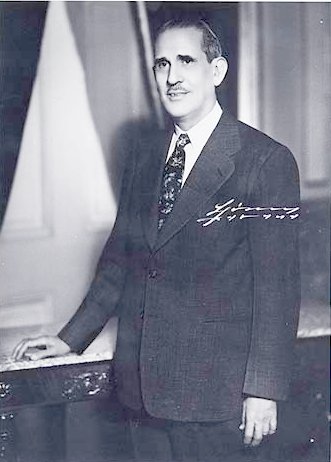- Ramón Grau
Infobox President
name =Ramón Grau

caption =
order = 7th
office = President of Cuba
term_start =10 September 1933
term_end =15 January 1934
vicepresident =None
predecessor =Carlos Manuel de Céspedes y Quesada
successor =Carlos Hevia
order2 = 15th
office2 = President of Cuba
term_start2 =10 October 1944
term_end2 =10 October 1948
vicepresident2 =Raul de Cardenas Echarte
predecessor2 =Fulgencio Batista
successor2 =Carlos Prío
birth_date =13 September 1887
birth_place =La Palma ,Pinar del Rio Cuba
death_date =28 July 1969
death_place =Havana ,Cuba
nationality = flagicon|Cuba Cuban
party = Cuban Revolutionary Party
otherparty =PRC-A
spouse =
relations =
children =
residence =
alma_mater =University of Havana
occupation =Medical Doctor
profession =
website =
footnotes =Dr. Ramón Grau San Martin (
September 13 ,1887 inLa Palma ,Pinar del Rio ,Cuba -July 28 ,1969 inHavana ,Cuba ) was a Cuban physician and the 7th and 15thPresident of Cuba (1933-34, 1944-48).Youth
His father, a rich tobacco grower, wanted him to continue in his footsteps, but he wanted to be a doctor. He studied at the
University of Havana and graduated in 1908 with a degree of Doctor of Medicine. He then lived in Europe to expand his medical knowledge and returned to Cuba in 1921 and became a professor of physiology at the University of Havana.Activism and the Revolution of 1933
In the 1920's he was involved with the student protests against then-president
Gerardo Machado , and in 1931 he was jailed. Upon his release he went into exile in the United States.Though he initially became President, he was eventually marginalized by army chief of staff
Fulgencio Batista , who distanced the military from other elements of the revolution and became "de facto" leader of Cuba behind the scenes. Batista forced Grau's resignation in 1934. That same year he went on to found thePartido Auténtico .His niece, Pola Grau Alsina (1915-2000), served as First Lady of Cuba.
Constitution of 1940
Grau was instrumental in passing the 1940
Cuban constitution . For much of the Constitutional Convention, he served as the presiding officer (even after his coalition was pushed into the minority after the defection of one of the parties that formed it). He would eventually come to be replaced byCarlos Márquez Sterling .In 1940 Grau ran in the presidential election and lost to
Fulgencio Batista . Most independent observers at the time qualified the 1940 election as free and fair elections.Election of 1944
In 1944 Grau won the popular vote in the presidential election and served until 1948. Despite his initial popularity in 1933, accusations of corruption tainted his administration's image, and a sizable number of Cubans began to distrust him.
After turning over the presidency to his protégé,
Carlos Prío , in 1948, Grau virtually withdrew from public life. He emerged again in 1952 to oppose Batista's coup d'etat. Grau ran for president in the 1954 and 1958 Batista-sponsored elections but withdrew just prior to each election day, claiming government fraud. After theCuban revolution and the rise ofFidel Castro in 1959, Grau retired to his home inHavana , where he died onJuly 28 ,1969 .References
* cite book
last = Otero
first = Juan Joaquin
authorlink =
title = Libro De Cuba, Una Enciclopedia Ilustrada Que Abarca Las Artes, Las Letras, Las Ciencias, La Economia, La Politica, La Historia, La Docencia, Y ElProgreso General De La Nacion Cubana - Edicion Conmemorative del Cincuentenario de la Republica de Cuba, 1902-1952
publisher =
series =
year = 1954
doi =
isbn = (Spanish)
*Argote-Freyre, Frank. "Fulgencio Batista: Volume 1, From Revolutionary to Strongman." Rutgers University Press, Rutgers, New Jersey. ISBN 0-8135-3701-0. 2006.
Wikimedia Foundation. 2010.
